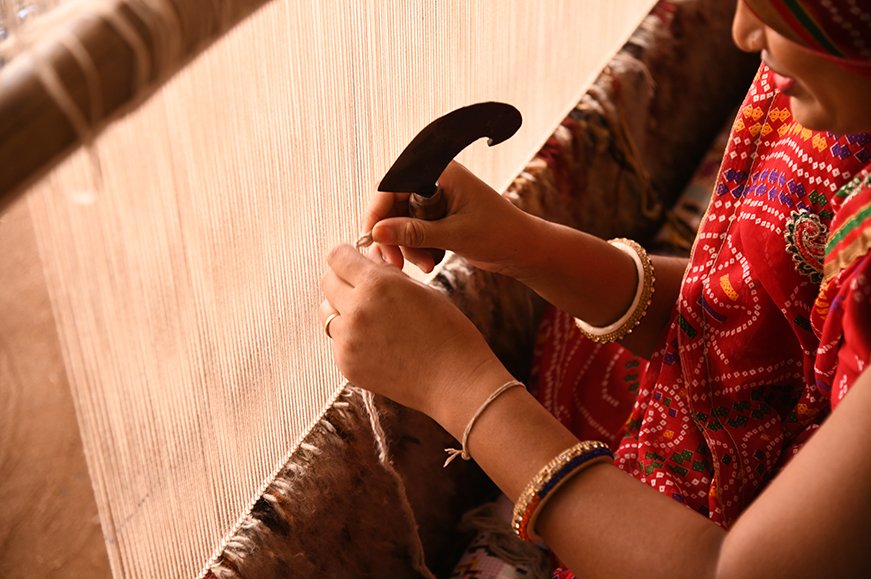Introduction
Hand-knotted rugs are more than just floor coverings; they are pieces of art that carry a legacy of craftsmanship passed down through generations. These rugs, known for their intricate designs and durability, add a touch of elegance and warmth to any space. But what makes hand-knotted rugs so special? In this guide, we will explore the meticulous process of creating these masterpieces, from selecting the right materials to finishing the final product. Whether you’re a novice weaver or simply curious about the art form, this guide will provide you with an in-depth look at the world of hand-knotted rugs.
Understanding Hand-Knotted Rugs
What is a Hand-Knotted Rug?
A hand-knotted rug is a type of carpet that is made by tying individual knots to the rug’s foundation. Each knot is meticulously hand-tied, creating a dense and durable weave. This traditional method is labor-intensive and requires a high level of skill, but the result is a rug that can last for generations.
Difference Between Hand-Knotted and Machine-Made Rugs
Hand-knotted rugs are often mistaken for machine-made rugs, but the two are vastly different. Machine-made rugs are produced using automated processes, which can replicate intricate designs but lack the uniqueness and durability of hand-knotted pieces. Hand-knotted rugs have a distinct texture and variability that reflect the artisan’s personal touch, making each rug one-of-a-kind.
Types of Hand-Knotted Rugs
There are several types of hand-knotted rugs, each with its own unique characteristics:
- Persian Rugs: Known for their elaborate designs and rich colors, Persian rugs are among the most sought-after hand-knotted rugs.
- Turkish Rugs: These rugs often feature geometric patterns and are known for their durability.
- Tibetan Rugs: Made with a unique knotting technique, Tibetan rugs often feature bold designs and vibrant colors.
Materials Needed for Hand-Knotted Rugs
Wool: The Primary Material
Wool is the most common material used in hand-knotted rugs due to its durability and natural stain resistance. It provides a soft, luxurious feel and can be dyed in a wide range of colors.
Silk: Adding a Touch of Luxury
Silk is sometimes used in high-end rugs for its sheen and softness. It adds a touch of luxury and is often used in combination with wool to create intricate patterns.
Cotton: For the Rug Foundation
Cotton is typically used for the warp and weft threads that form the foundation of the rug. It provides a sturdy base that helps maintain the rug’s shape over time.
Tools Required: Loom, Knotting Tools, Scissors
To create a hand-knotted rug, you’ll need specific tools including a loom to hold the warp threads in place, knotting tools to tie the knots, and scissors for trimming the excess threads.
Designing Your Rug
Choosing a Design: Traditional vs. Modern
The design of your rug is a crucial aspect of the creation process. Traditional designs often feature intricate floral patterns and borders, while modern designs may incorporate abstract shapes and bold colors. Your design choice will set the tone for the entire rug-making process.
Sketching the Rug Design
Before starting the knotting process, it’s essential to have a clear sketch of your rug’s design. This blueprint will guide you as you work, ensuring that the final product matches your vision.
Color Selection and Dyeing Process
The colors you choose for your rug will bring your design to life. Natural dyes are often preferred for their rich, authentic hues. The dyeing process involves boiling the wool in large vats with the chosen dyes, ensuring that the colors are vibrant and long-lasting.
Setting Up the Loom
Understanding the Loom Structure
The loom is the backbone of your rug-making process. It holds the warp threads taut, allowing you to tie knots with precision. Understanding how to set up and adjust the loom is key to creating a well-balanced rug.
Preparing the Warp Threads
The warp threads form the vertical structure of the rug. These threads are usually made from strong cotton and are stretched across the loom to create a framework for the knotting process.
Tensioning the Warp for Weaving
Proper tensioning of the warp threads is crucial for ensuring that the rug maintains its shape during and after weaving. The threads should be evenly spaced and taut, providing a sturdy foundation for the knots.
The Knotting Process
Introduction to Different Knotting Techniques
Knotting is the heart of hand-knotted rug making. There are several knotting techniques, each producing a different texture and appearance.
The Turkish Knot (Ghiordes Knot)
The Turkish knot, also known as the Ghiordes knot, is a symmetrical knot where the yarn is looped around two warp threads. This knot creates a more textured and durable rug.
The Persian Knot (Senneh Knot)
The Persian knot, or Senneh knot, is an asymmetrical knot that is tied around one warp thread, producing a finer, more detailed weave. This knot is often used in rugs with intricate designs.
Step-by-Step Knotting Instructions
- Start by looping the yarn around the warp threads.
- Pull the yarn tight to form a knot.
- Cut the excess yarn with scissors.
- Repeat this process across the row, maintaining consistency in knotting tension and size.
Creating the Pile
How to Determine the Pile Height
The pile height refers to the length of the yarn above the knot. It can range from low (short and dense) to high (long and plush). The pile height is determined by the design and intended use of the rug.
Trimming the Pile
Once the knotting is complete, the pile is trimmed to an even height using special shears. This step is crucial for achieving the desired texture and appearance of the rug.
Importance of Pile Density
Pile density refers to the number of knots per square inch. A higher density means more knots, resulting in a more durable and luxurious rug. Rugs with
You May Also Like : Handmade Rugs in Agra, Rugs in Agra

